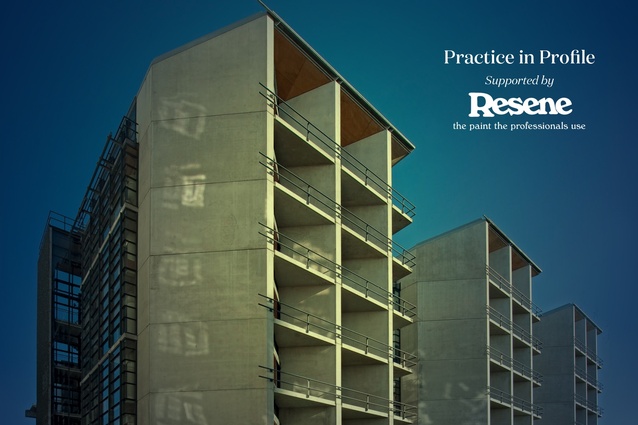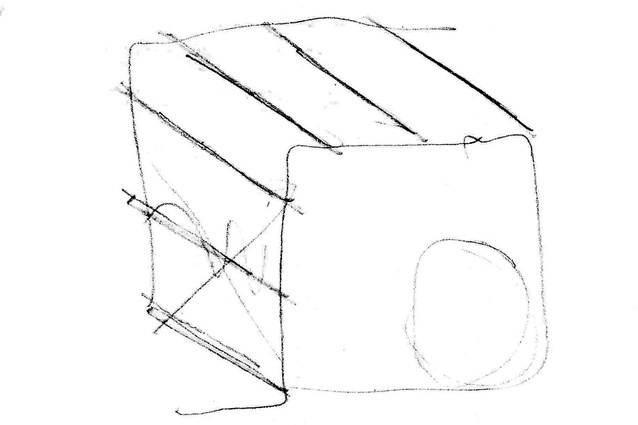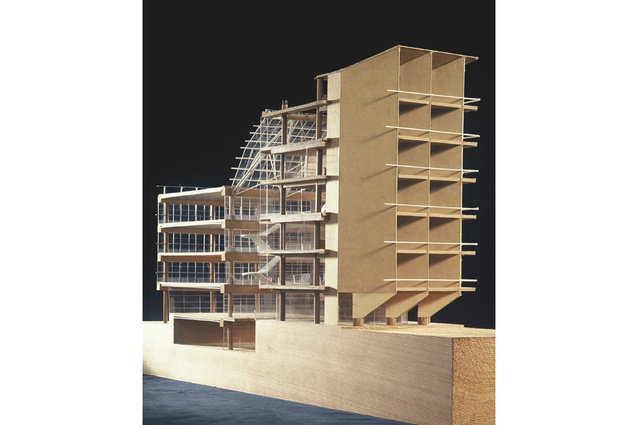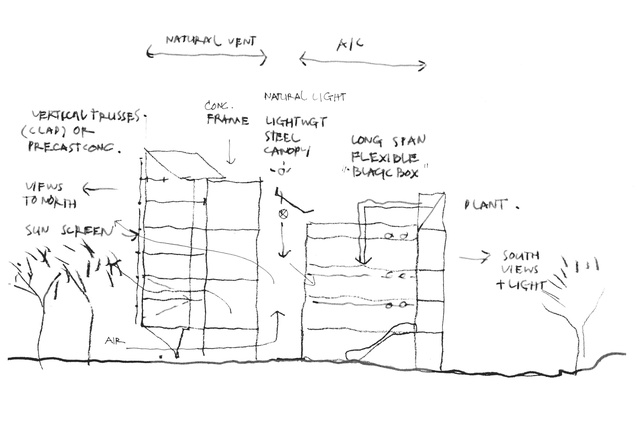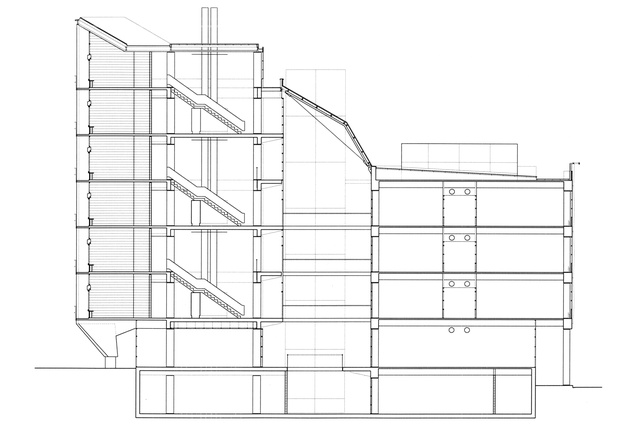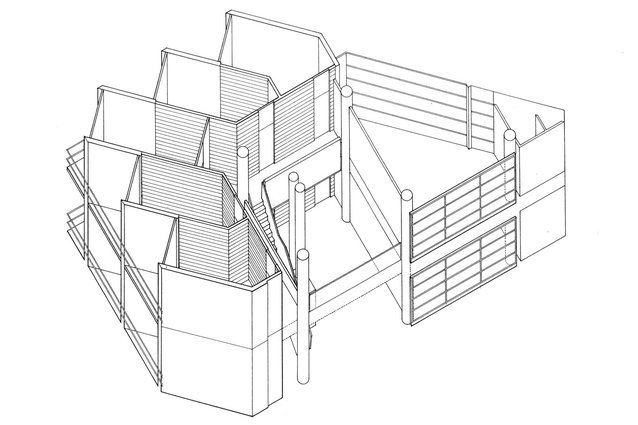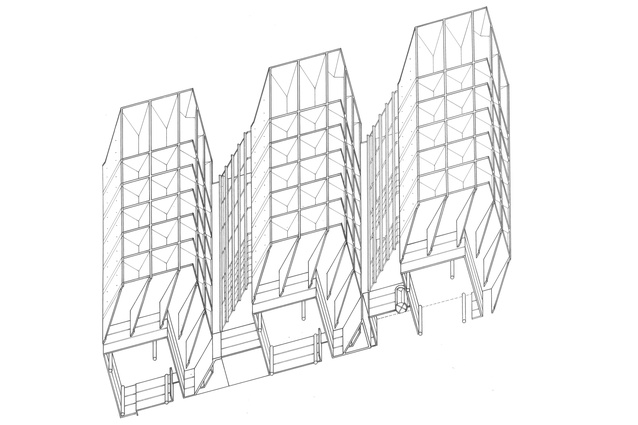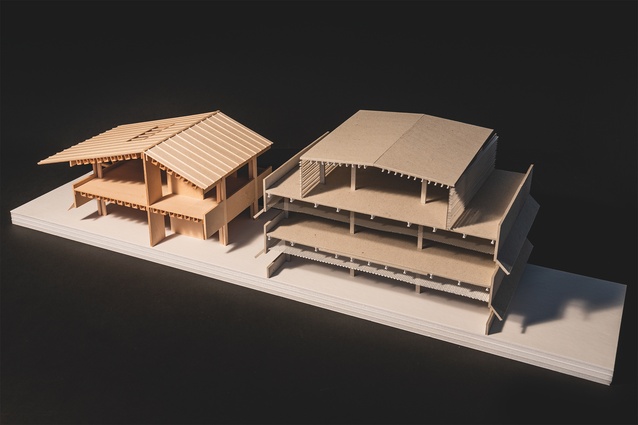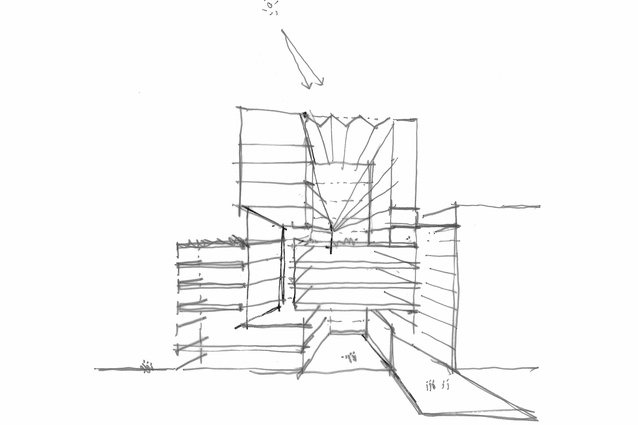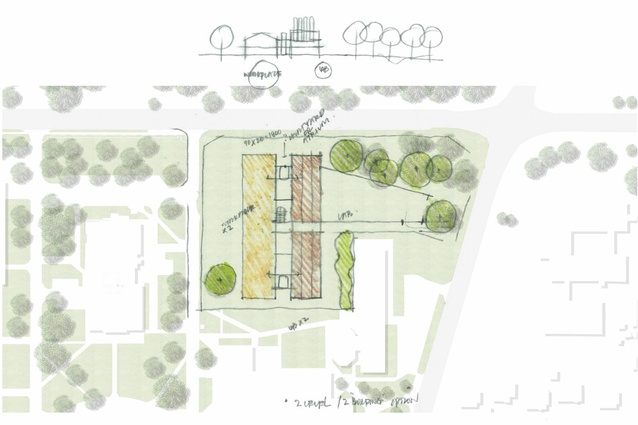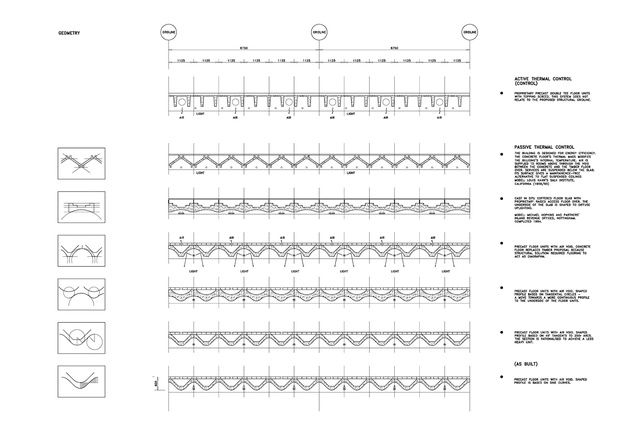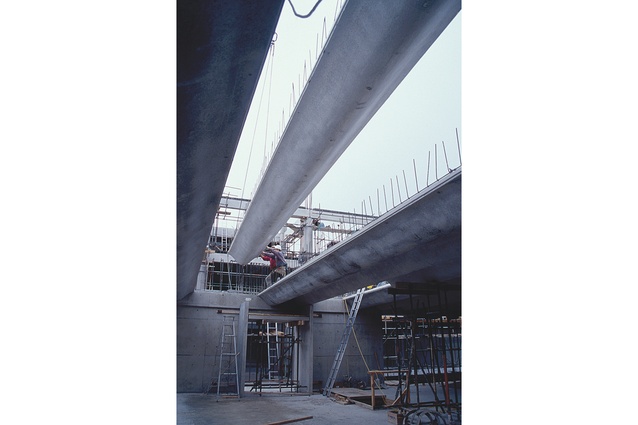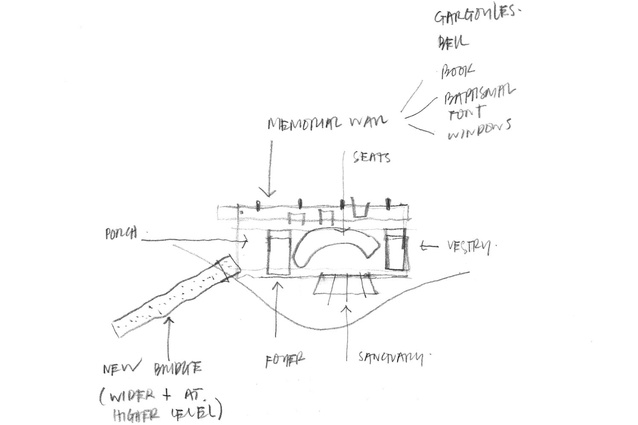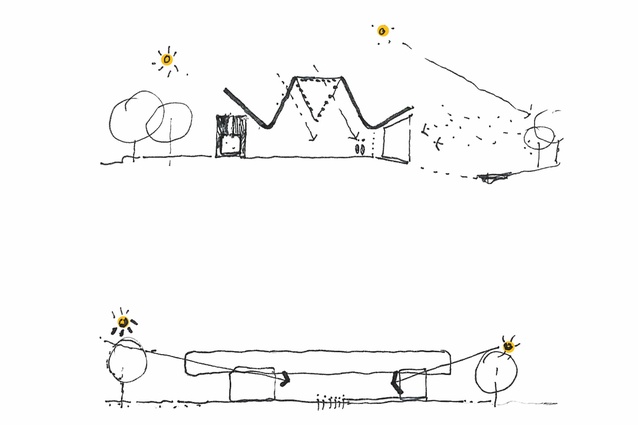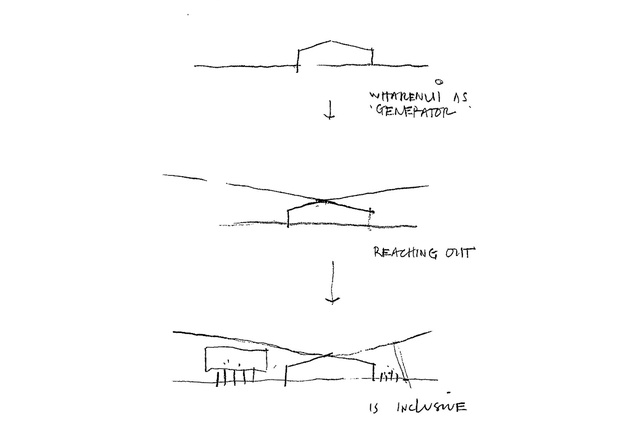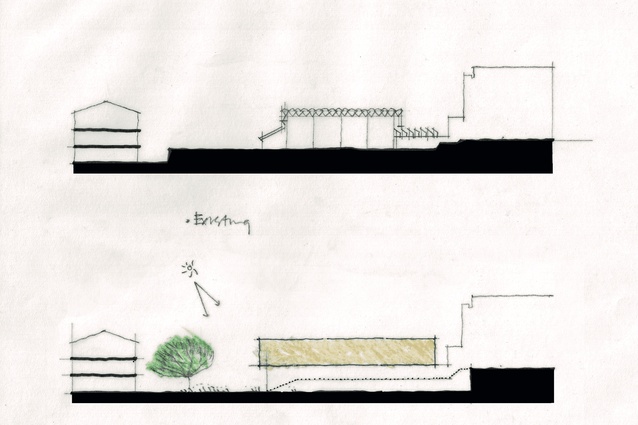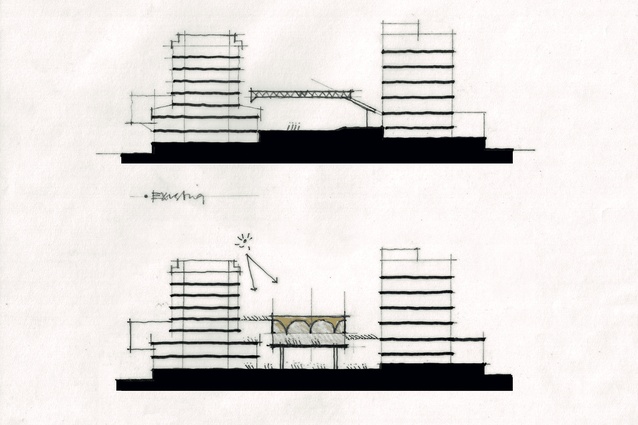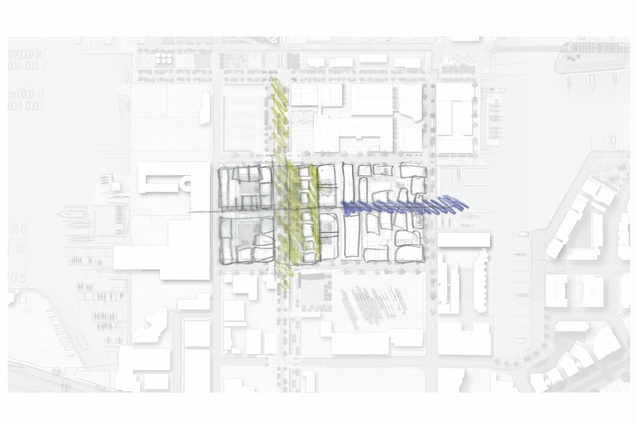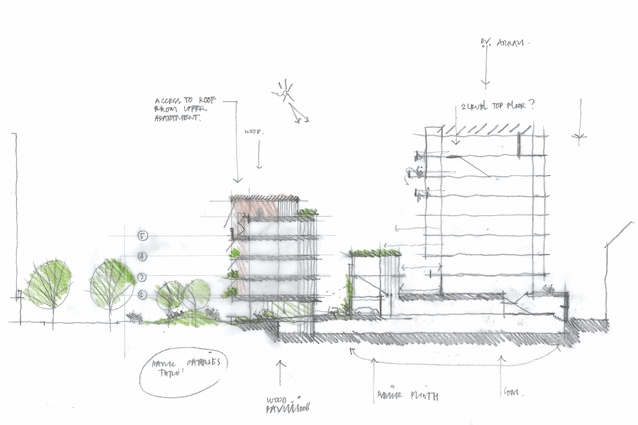Inspiration by incident
Patrick Clifford reflects on what comprises the Architectus design process. He finds a heady mix of methods: from sociograms to serendipity, iterations, words generating spatial arrangements, co-design, collaboration, questioning the extent of the site and asking “why not?” to the primacy of the pin-up, to name a few.
When I look back on the work of our practice of some 35 years, there are many common themes and concerns that connect the individual projects. From the earliest efforts, we have tried to steer the work to be formally spare and programmatically dense, contextually self-conscious, spatially rich, carefully crafted, long-lasting and experientially based. Option studies, models and precedent, especially places and spaces we have been to and experienced, inform the process; clarity is everything and a few aphorisms like ‘the section is generator’ endure. We try to gather our thoughts at the outset of any work and understand what we can bring both to the task and, more importantly, to the places and people of which it will become a part.
For most of the work, in my memory at least, there are moments, though, that stand out that could be characterised as ‘inspiration by incident’. This could also be thought about as a kind of selective thinking, as it gives priority to some aspect of the project: not necessarily the most important but one that gives the work impetus and direction and, for better or worse, sets the agenda for the task at hand and, often, others in the future.
The incident referred to here is generally a moment in the iterative design phase where a trajectory for the project is found. This can be precipitated by the pressure of time – that is, it has run out and something simply must be done – but, more often, by a connection that unlocks a commitment to progress. This may relate to an overarching framework for the work but, equally, can concern only a part of it and may be traced to a consideration of type or history or precedent, to narrative or tectonics. Key in this is the idea of connection so it may stem from a discussion with colleagues, clients or collaborators, which triggers an investigation or confirms a direction. This is, at once, both reductive and universal; this touchstone cannot address every aspect of a project but becomes the reference point, the whakapapa or the genesis that will guide its progress.
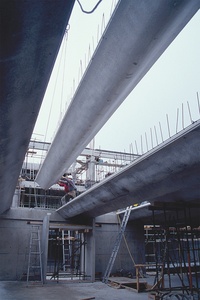
Of course, the connections that any individual sees are, I imagine, a result of all that has been seen before, as well as that which is ‘new’, that may precipitate previously unexplored or seemingly improbable outcomes. A constant topping up and refreshing of the reservoir of precedents is fundamental to this, also, even though there is no necessary pattern to the timing (or clarity) of recall. Salman Rushdie writes that stories give rise to other stories;1 architecture, similarly, gives rise to other architecture.
I now know that if, for example, a project is seemingly circling without purpose, the act of presenting or sharing that unresolved collection to others can provide clarity and direction. This applies to work with other disciplines, with clients or users and with codesign partners, as if the very act of talking created it.
Given that time does not seem to have changed this incidental process, that is, it is still happening today as it did in the ’80s, Marshall Cook’s observation from that time that most architects have only one or two ideas ever, and these are simply recycled, could probably apply equally to the process as well as to the product. In fact, over time, we have sought to increase the opportunity for ‘chance’, perhaps a contradiction in terms, by leaving decisions for as long as possible, creating multiple options, always agreeing (within reason) to look at suggested alternatives, committing to share design thinking when it is yet to exist and, of course, assembling a thorough understanding of context – physical, cultural, social and economic – and precedent as a backbone to the work. The evolution of design tools has challenged this approach. We have been used to layers of butter paper allowing the blurring of thoughts, models that are inherently selective, and plans, sections and elevations that are related but not always consistent (but will, over time, become so). Utilising tools that naturally align design vectors has required other skills to allow the unresolved and inconsistent to persist.
Competitions and collaborations provided a pathway for our young practice to a more ‘public’ architecture than the alterations to existing buildings and the odd new house. Not that success was immediate or recurrent but, after some seven years of trying, the Architectus/Cook Hitchcock Sargisson/Royal Associates plan for the Sciences West Precinct, and the two major buildings we proposed, amongst 14 or so other invited submissions, were adopted by the University of Canterbury Te Whare Wānanga o Waitaha. Given the library was documented but unbuilt, the precinct remains only partly realised by the Erskine Building and its surrounds. Documents, including the brief along with a particle-board base for a required model, were sent to us. There was a question period but no opportunity to interact with the university. Well into the competition period, I recall rereading the Erskine brief (carefully crafted by faculty, facilities and the professional advisor) and realising that, whilst much of it was important but expected, several paragraphs were not. Initially, they seemed to describe an unrealisable set of relationships…
Ignoring the formal implications, we found it possible to organise groups of five rooms in a cluster-like pattern facing north, with teaching spaces to the south of these, but no more. It was only in the exclamation that 10 simply did not fit that the realisation dawned that five on each of two levels around a double-height space would, and would also create the room for informal meetings between staff and students. This connection between words and a spatial arrangement formed the basis of the project and, despite the strange 45-degree geometry, even to dedicated Kahn devotees, we committed to it. The resulting section describes a set of physical relationships and possibilities that stages the life of an academic community.
In our own lexicon, we have referred to these kinds of spatial configuration as “sociograms” – spatial social networks – and they have been at the core of many projects. Thus, this incident that connected and cascaded at the Erskine Building has cascaded into other projects.
The Science Centre at the University of Auckland Waipapa Taumata Rau is formed around a spatial sequence that derives from the connection between the massing required by the city plan and the questioning of the atrium as a socially occupiable space. The latter is often good on the edges: good to move through but hard to activate on the ground plane, as the scale can be overwhelming. We evolved the diagram to be a series of connected overlapping rooms.
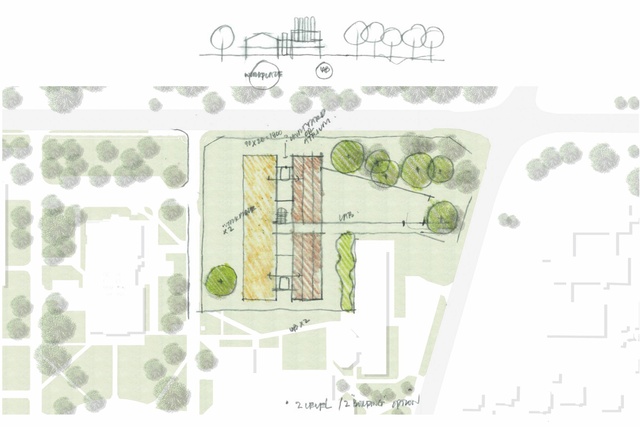
At AgResearch near Ōtautahi Christchurch, the aggregation of places for research as distinct from other work allows difference to be enhanced. This permeates the project at a spatial level as well as in the way it is made. Structure, skin and services are chosen to be appropriate to purpose as well as to give greater difference to the traditional arrangement of research and write-up spaces. Formal expression follows this protocol, too.
In a related cascade, there is a crossover into the way environmental factors are arranged – the sociogram creates a set of pathways and relationships for people; where people move through, so, too, can light and air. This symbiosis we have considered to provide an axiomatic assurance that, if the diagram is good for social connection and interaction, so it will allow pathways for light and air alongside stairs that invite use; structures that can do more than one job are lean and organised in ways that will enable reuse and refit.
At the Centennial Chapel at St Andrew’s College Te Kāreti o Hāto Ānaru Te Kotahi Rau Tau o te Whare Karakia, the brief was very thoughtful, challenging and expressive of the values and aspirations of the community. Against a background of as much professional as personal experience of religious spaces, certain considerations stood out as they had done with the Erskine Building. In this case, it was the inclusion of a list of salvageable items to consider incorporating in the new work and a summation of aspects of the Presbyterian tradition,2 with a concluding paragraph (below).
These coalesced in our explorations. Aggregating the heritage items into a memorial wall was, at first, an organisational convenience but this revealed a set of connections, both environmental and spatial, as well as, most significantly, emotional and ecclesiastical. The wall holds both the literal and metaphorical memory of the former chapel and of the fallen Old Collegians in World War II and it establishes the response to the challenge of representing that creative tension referred to above. The memorial wall is timeless and universal; a folded glass wall, parallel to it, contextual and situational, looks across the college fields to the Port Hills.
References in this discussion to ‘the brief’ may seem rather quaint in a time when the design team is often charged with developing that document around a series of workshops or hui, or the brief evolves iteratively in parallel with the project itself. Processes that are lessbinary than they were in the decades where our work began, codesign with iwi or user groups, and participatory community design all offer the chance for connections to be made in the project outcome as well as in the process, and the possibilities for inclusive outcomes. This is particularly relevant in our work in libraries, universities and other broadly public architecture and place- making but what continues to surprise me is the serendipity, casualness perhaps, that determines much of what we do.
There is opportunity, too, of course, in the questioning of constraints. At Victoria University of Wellington Te Herenga Waka, ‘The Hub’, as the name suggests, is premised on linking people, places and events. An Architectus/Athfield Architects project, it began with a series of studies that both built up a picture of the existing complex and variable conditions and proposed possible responses. These were even more complex and varied. The questioning of the sectional extent of the site changed that dynamic and enabled a response that dramatically reduced that complexity and variability.
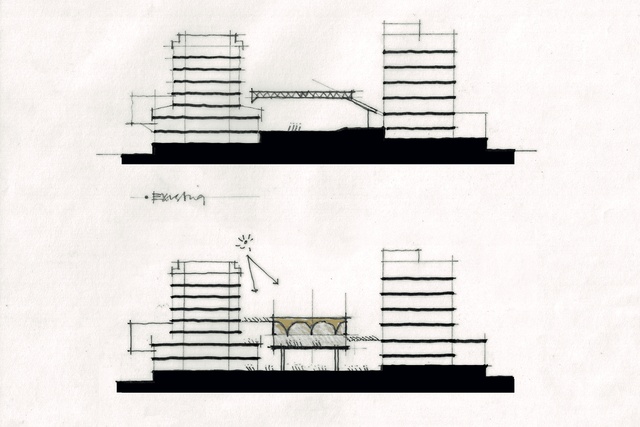
We proposed that we would excavate a large part of the given site, necessitating significant underpinning of existing structures, and demolish an existing lecture hall. That the university could agree to this, especially the latter, given all the consequential disruption, is testament to the benefit of the resolution of circulation and movement and the creation of quality open space that resulted from the excavation. Again, there are many other forces at work in this project, particularly in terms of the ways in which the library, in the broad sense, is conceived, but the impetus for the way this is shaped came from a simple reductive move.
The strategy of connection of The Hub is now being further developed in The Pā at the University of Waikato Te Whare Wānanga o Waikato. The section as generator is enriched programmatically and metaphorically in the Architectus/Jasmax project by the pairing of the wharenui and a wing for the executive leadership team along with the refurbished home for the Faculty of Māori and Indigenous Studies, framing the context for both informal and formal gathering of this community.
Over a 20-year time frame, we have been engaged in various projects at Wynyard Quarter, including the mixed-use, but predominantly housing, Wynyard Central – the subject of a competitive procurement process. This, on a site for which we had previously created, with others, a framework plan and a reference design. The extensive prior work may, initially, seem limiting but, working alongside other architects (Athfield Architects and Studio Pacific Architecture, each responsible for a piece of a collaborative whole – another parallel competitive process) and both our developer client and the city, a new set of possibilities emerged.
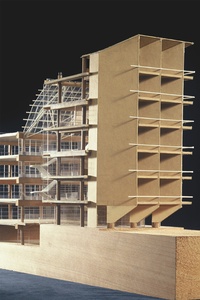
One discussion, or incident, again provided the momentum to our response and it revolved around the relationship of building mass to the street edge. The client simply asked “why not?” to an assertion that one would never put the larger building element away from the street. In reviewing our own assumption subsequently, we found a strategy that did exactly that and much else, and which we pursued through the design process and is now built and occupied. It is not to suggest here that this is now a new axiom but that a simple, almost-casual query, set the direction.
Our current predicament, in the grip of a pandemic, challenges the opportunistic nature of much that is described here. Challenged, too, is the opportunity to experience the built environment, the spatial world rather than the descriptive world that focuses on the formal. Working separately, as many of us are, despite the power of sharing tools, must influence what we do. The challenge, of course, is to recreate the studio pin-up, the inspiration from seeing something over someone’s shoulder or in a book or journal, the kōrero before or after a hui or the myriad of other ways this occurs.
At the risk of sounding voyeuristic, the dusk escape from a virtual world to ‘en plein air’ around the neighbourhood, and the glimpses it gives of other lives and into other places, will have to do for now.
Patrick Clifford is one of the founding principals of Architectus, a former president of Te Kāhui Whaihanga New Zealand Institute of Architects (NZIA) and an NZIA Gold Medal recipient (2014). He has been both critic and tutor at the University of Auckland and Unitec schools of architecture over many years, including a two-year adjunct professorship at Unitec. Clifford has lectured widely on the work of Architectus and has contributed to a range of industry groups and organisations.
1 Shelley Hepworth, ‘I guess I’m having a go at killing it’: Salman Rushdie to bypass print and publish next book on Substack, The Guardian, 1 September, 2021.
2 As outlined in the St Andrew’s College brief, which is included in John Walsh’s St Andrew’s College Centennial Chapel Te Kāreti o Hāto Ānaru Te Kotahi Rau Tau o te Whare Karakia, Architectus Bowes Clifford Thomson, 2018, pp. 23–28.

